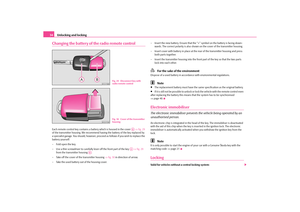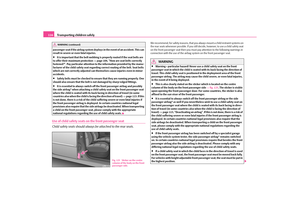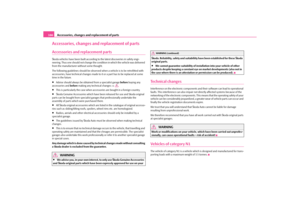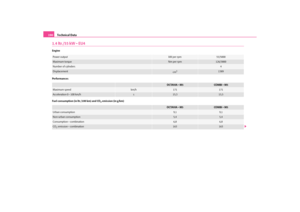Page 57 of 207

Seats and Storage
56
Seats and StorageFront seatsBasic informationThe front seats have a wide range of differ ent settings and can thus be matched to the
physical characteristics of the driver and front passenger. Correct adjustment of the
seats is particularly important for:
safely and quickly reaching the controls;
a relaxed, fatigue-free body position;
achieving the maximum protection offered by the seat belts and the airbag
system.
WARNING
Never transport more occupants than the maximum seating in the vehicle.
Each occupant must correctly fasten the seat belt belonging to the seat.
Children must be fastened page 115, “Transporting children safely” with a
suitable restraint system.
The front seats and the head restraints must always be adjusted to match
the body size of the seat occupant as well as the seat belts must always be
correctly fastened in order to provide an optimal protection for you and your
occupants.
Always keep your feet in the footwell when the vehicle is being driven -
never place your feet on the instrument panel, out of the window or on the
surfaces of the seats. This is particular ly important for the front seat passenger.
You will be exposed to increased risk of injury if it becomes necessary to apply
the brake or in the event of an accident. If an airbag is deployed, you may suffer
fatal injuries when adopting an incorrect seated position!
It is important for the driver and front passenger to maintain a distance of
at least 25 cm from the steering wheel or dash panel. Not maintaining this
minimum distance will mean that the airbag system will not be able to properly
protect you - hazard! The front seats and the head restraints must always also
be correctly adjusted to match the body size of the occupant.
Ensure that there are no objects in the footwell as any objects may get
behind the pedals during a driving or braking manoeuvre. You would then no
longer be able to operate the clutch, to brake or accelerate.
Adjusting the front seatsAdjusting a seat in a forward/back direction– Pull the lever fig. 54 up and push the seat into the desired position.
– Release the lever and push the seat further until the lock is heard to engage.Adjusting height of seat*– Lift the seat if required by pu lling or pumping lever upwards.
– Lower the seat if required by pushing or pumping lever downwards.Adjust the angle of the seat backrest– Relieve any pressure on the seat backrest (do not lean on it) and turn the hand- wheel fig. 54 to adjust the desired angle of the backrest.
WARNING (continued)
Fig. 54 Controls at seat
A1A1
A2A2
A3
s2rc.book Page 56 Thursd ay, April 22, 2010 10:58 AM
Page 58 of 207

Seats and Storage57
Using the system
Safety
Driving Tips
General Maintenance
Breakdown assistance
Technical Data
Adjusting lumbar support*– Turn the wheel until you have set the most comfortable curvature of the seat
upholstery in the area of your spine.
The driver's seat should be adjusted in such a way that the pedals can be fully pressed
to the floor with slightly bent legs.
The seat backrest on the driver's seat should be adjusted in such a way that the upper
point of the steering wheel can be easi ly reached with slightly bent arms.
WARNING
Only adjust the driver seat when the vehicle is stationary - risk of injury!
Take care when adjusting the seat! Adjusting the seat without care can lead
to bruises or injuries.
The seat backrests must not be angled too far back when driving otherwise
this will affect proper operation of the se at belts and of the airbag system - risk
of injury!
Adjusting front seats electrically*Adjusting seats
Adjusting seat– Adopt the correct seated position page 56.
– Press the switch or in the direction of the desired setting fig. 55 .Adjusting lumbar support– Adjust the lumbar support mechanic ally by turning the rotary knob .
Switch is operated in order to move the seat up/down and forward/back, while
switch is operated in order to move the seat backrest forward or back.
WARNING
Only adjust the driver seat when the vehicle is stationary - risk of injury!
Caution when adjusting the seat! You ma y suffer injuries or bruises as a
result of adjusting the seat without paying proper attention.
In view of the fact that the seats can also be adjusted when the ignition is
switched off (even when ignition key withdrawn), you should never leave chil-
dren unattended in the vehicle.
The seat backrests must not be angled too far back when driving otherwise
this will affect proper operation of the se at belts and of the airbag system - risk
of injury!Note
If the movement of the seat is inadvertently interrupted during an adjustment, once
again press the switch in the appropriate di rection and continue with the adjustment
of the seat to the end.
A4
Fig. 55 Side view: Controls for
adjusting the seat
AA
AB
AC
AAAB
s2rc.book Page 57 Thursd ay, April 22, 2010 10:58 AM
Page 59 of 207

Seats and Storage
58
Storing settingStoring seat and exterior mirror settings for driving forward– Switch on the ignition.
– Adjust the seat page 57.
– Adjust both exterior mirrors page 54.
– Press one of the memory buttons and hold the button pressed for about 3 seconds until an audible signal confirms that the setting has been stored. The
setting of this button was stored.Storing exterior mirror setting for reversing*– Switch on the ignition.
– Turn the exterior mirror control to position
page 54.
– Engage the reverse gear.
– Move the right exterior mirror into the desired position page 54.
– Press one of the memory buttons and hold the button pressed for about 3 seconds until an audible signal confirms that the setting has been stored. The
setting of the selected button was stored.
The memory system can be deactivated at any time with the button . The seat and
the exterior mirrors can al so be manually operated. Memory buttons
Memory for the seat offers the possibility to store the individual driver seat and
external mirror position. An individual posi
tion can be allocated to each of the three
memory buttons page 58, fig. 56 , that is three in total. By pressing the appro-
priate memory button the seat and external mirror will automatically move into the
position allocated to this button page 59.
Note
When storing settings with the memory buttons, we recommend that you begin
with the front button and assign a memory button to each additional driver.
Each new setting stored with the same button erases the previous setting.
Each time you store the seat and exterior mirror settings for driving forward you
also have to re-store the individual setting of the exterior mirror on the passenger side
for reversing.
Assigning radio remote cont rol* to the memory buttonsAfter storing the settings of the seat and exterior mirrors, you have 10 seconds in order
to assign the radio remote control to the appropriate memory button.
– Withdraw the ignition key.
– Press the release button page 39 and hold it presse d for 1 second until an
audible signal confirms that the setting has been stored. The setting is stored with
the memory button which you have selected.
If you wish to be able to retrieve the settings which are stored in the memory by also
using the radio remote control, you have to assign the radio remote control to a
memory button in each case.
If you wish, you can obtain an additional re mote control key from a specialist garage
and then assign the remote contro l key to another memory button.
Note
If the radio remote control had previous ly been assigned to another memory
button, this setting is then erased by the new assignment.
Fig. 56 Driver seat: Memory
buttons and the button MEM
OFF
ADAD
AE
AD
AD
s2rc.book Page 58 Thursd ay, April 22, 2010 10:58 AM
Page 60 of 207

Seats and Storage59
Using the system
Safety
Driving Tips
General Maintenance
Breakdown assistance
Technical Data
If you assign the radio remote control to a memory button which has already been
assigned to a radio remote control, the ol d assignment is also replaced by a new
assignment in this case.
The assignment of the radio remote co ntrol to a memory button is retained,
however, after reassigning the seats and exterior mirrors.
Retrieving seat and exterior mirror settings for driving forward
You can retrieve the stored settings either with the memory button
or also with the radio remote control*.Retrieving the settings of the seat and mirrors can only be carried out when the igni-
tion is switched off for safety reasons. Retrieving the settings can be carried out in two
different ways:Retrieving settings with memory buttons– By pressing briefly: with the door open, operate the desired memory button
page 58, fig. 56 with one-touch. The seat and the exterior mirrors now move
automatically into the stored position.
– By pressing for a long period of time: with the driver door open or closed, press
and hold the desired memory button until the seat and the exterior mirrors
have moved into the stored position.Retrieving settings with remote control*– If the driver door is closed and the ignition is switched off, briefly press the unlock button of the radio remote control page 39 and then open the driver door.
– The seat and exterior mirrors now move automatically into the stored positions.Retrieving setting of exterior mirror for reversing*– Turn the rotary knob for the exterior mirror setting into the position
page 54
before engaging the reverse gear.
Emergency Off– Press any button on the driver seat.
Note
If the memory button is pressed once agai n during the automatic setting of the seat
and the exterior mirrors, the setting operation is interrupted. After repeated pressing
of the same button, the setting operation is continued to the end. If one of the two
remaining memory buttons is pressed, the stored setting of this button is retrieved.Information concerning the off switch of the memory systemAfter pressing the off switch page 58, fig. 56 of the memory system, the memory
system is deactivated. You can only adjust the seat and the exterior mirrors manually.
You can switch on the memory system again by once again pressing the off switch
of the memory system. The setting is not ca rried out to the end if a retrieved setting
operation is interrupted.
We recommend that you switch off the memo ry system with the off switch if the
vehicle is used for a short period by a driver and you do not wish to store any particular
settings of the seat and mirrors in this case.Head restraints
ADAD
AD
AE
AE
AE
AE
Fig. 57 Head restraint: adjusting
s2rc.book Page 59 Thursd ay, April 22, 2010 10:58 AM
Page 61 of 207

Seats and Storage
60
Best protection is achieved if the top edge of the head restraint is at the same level as
the upper part of your head.Adjusting the height of a head restraint– Grasp the side of the head restraint with both hands and push the head restraint up or down in direction of arrow page 59, fig. 57 .Adjusting the angle of a head restraint– The head restraint can be matched to the head of the occupant by adjusting the
angle in the direction of the arrow page 59, fig. 57 . Adjusting the angle of the
head restraint provides enha nced comfort for the user.Removing and installing a head restraint– Pull the head restraint out of the seat backrest as far as the stop.
– Press the locking button in the direction of arrow page 60, fig. 58 and pull the
head restraint out.
– To re-insert the head restraint, push it down into the seat backrest far enough until you hear the locking button engage.
The head restraints must be adjusted to ma tch the size of the seat occupant. Correctly
adjusted head restraints together with the seat belts offer effective protection for the
occupants page 98.
WARNING
The head restraints must be correctly adjusted in order to offer effective
protection for the occupants in the event of an accident.
Do not drive under any circumstance with removed head restraints - risk of
injury!
Rear seatsFolding the rear seats forwardsThe luggage compartment can be increased in size by folding the rear seats forwards.
Before folding the rear seats forwards, it is required to adapt the position of the front
Fig. 58 Removing a head
restraint
AAAB
Fig. 59 Folding the seat cushion
forwardsFig. 60 Unlock the seat backrest
s2rc.book Page 60 Thursd ay, April 22, 2010 10:58 AM
Page 62 of 207

Seats and Storage61
Using the system
Safety
Driving Tips
General Maintenance
Breakdown assistance
Technical Data
seats and the armrest in such a way that no mutual deformation or damage can occur
to the seats.
Folding seats forwards– Before folding the rear seats forwards, yo
u must adapt the position of the front
seats in such a way that they are not damaged when the rear seats are folded
forwards.
– Pull up the seat cushion in direction of arrow and fold forwards in direction of arrow page 60, fig. 59 .
– Unlock the seat backrests by pulling the securing knob page 60, fig. 60 and fold
them forwards.
– Remove the head restraints from the seat backrests and fold the backrests
completely forwards.
– The head restraints can be inserted into the relevant holes of the folded forward
seat cushions.
If the front seats are too far back, we recomm end that you have the rear head restraints
removed before the seat backrests are folded forward. Store the removed head
restraints in such a way that they cannot be damaged or soiled. Please refer to the
guidelines page 63, “luggage compartment”.Move seats into the initial position
Move seats into the initial position– Install the head restraints in the slightly lifted seat backrest.
– Place the rear lateral seat belt fig. 61 behind the edge of the side trim panel.
– Then push the seat backrest back into th e upright position until the securing knob
clicks into place - check by pulling on the seat backrest.
– Move the seat cushion into its original position.
WARNING
The belts and the belt locks must be in their original position after folding
back the seat cushions and the seat backrests - they must be ready to use.
The seat backrests must be securely interlocked in position so that no
objects in the luggage compartment can slide into the passenger compartment
if there is sudden braking - risk of injury!
Pay attention that the seat backrests are correctly interlocked. It is only then
that the three-point seat belt for the middle seat can reliably fulfil its function.
Before folding the seat backrest back into the secure position, place the rear
lateral seat belt behind the edge of the si de trim panel. Take suitable measures
to prevent that the seat belt is jammed between the seat backrest and the side
trim panel and is thus damaged.
Removing the seat cushion
A1
A2
Fig. 61 Lock the seat backrest
AA
Fig. 62 Removing seat cushions
s2rc.book Page 61 Thursd ay, April 22, 2010 10:58 AM
Page 63 of 207

Seats and Storage
62
The luggage compartment can be increased furt her in size by removing the rear seat.Removing– Fold the seat cushion forwards completely.
– Press the wire clamps in the direction of the arrow fig. 62 and remove the seat
cushion from its holder.Installing– Press the wire clamps in the direction of the arrow and place it in its holder.
– Fold the seat cushion back into its original position.Seat heating of the front seats*You can electrically heat the seat cushions and the seat backrests of the front seats
when the ignition is switched on.Front seats– He ating on the driv er's and f ront pa se nger's s eat can be swi tche d on and regula te d by turning the control dial fig. 63 .
– The system is switched off by turning th e control dial to the home position “0”.
WARNING
If, as an occupant, you have a subdued pa in and/or temperature sensitivity, e.g.
through medication, paralysis or because of chronic illness (e.g. diabetes), we
recommend not to use the seat heating. This can lead to burns on the back, the
posterior and the legs which are difficult to heal. If the seat heating is used, we
recommend to make regular breaks in your journey when driving long
distances, so that in specific cases as mentioned above the body can recuperate
from the stress of the journey. Please consult your doctor, who can evaluate
your specific condition.
Caution
You should not kneel on the seats or otherwise apply pressure at specific points in
order to avoid damaging the heating elements of the seat heaters.
Do not clean the seats moist page 142.Note
The seat heating should only be switched on when the engine is running. This has
a significant effect of savi ng on the battery capacity.
If the on-board voltage drops, the seat heating is switched off automatically, in
order to provide sufficient electrical energy for the engine control.
PedalsConcerning a secure de pressing of the pedal, you should use only footmats from the
Škoda genuine accessories.
Operation of the pedals must not be hindered!
WARNING
Greater pedal distances may be needed when there is a fault in the brake
system.
Do not place any footmats or other additional floor coverings in the area of
the pedals in order to ensure that all the pedals can be fully depressed and are
able to return unobstructed to their initial position - risk of accident!
Fig. 63 Dash panel: Control dial
for heating the front seats
s2rc.book Page 62 Thursd ay, April 22, 2010 10:58 AM
Page 64 of 207

Seats and Storage63
Using the system
Safety
Driving Tips
General Maintenance
Breakdown assistance
Technical Data
There must be no objects on the floor which could roll under the pedals. You
would then no longer be able to apply the brakes, operate the clutch or accel-
erator - risk of accident!
luggage compartmentLoading the luggage compartmentPlease observe the following in the interest of having good handling characteristics of
your vehicle:
– Distribute the items of luggage as evenly as possible.
– Place heavy objects as far forward as possible.
– Attach the items of luggage to the lashing eyes or the fixing net* page 64.
In the event of an accident, there is such a high kinetic energy which is produced by
small and light objects that th ey can cause severe injuries. The magnitude of the kinetic
energy depends on the speed at which the vehi cle is travelling and on the weight of the
object. The speed at which the vehicle is travelling is in this case the more significant
factor.
Example: In the event of a frontal collision at a speed of 50 km/h, an unsecured object
with a weight of 4.5 kg produces an ener gy, which corresponds to 20 times its own
weight. This means that it results in a weight of approx. 90 kg. You can imagine the inju-
ries that can occur, if this “bullet” is fl ying through the interior compartment and hits
an occupant.
WARNING
Stow the objects in the luggage compartm ent and attach them to the lashing
eyes.
Loose objects in the passenger compartment can be thrown forward during
a sudden manoeuvre or in case of an accident and can injure the occupants or
other oncoming traffic. This risk is still increased, if the objects which are flying around are hit by a deployed airbag. In this case, the objects which are thrown
back can injure the occupants - hazard.
Please note that the handling properties of your vehicle may be affected
when transporting heavy objects as a result of the displacement of the centre of
gravity. The speed and style of driv ing must be adjusted accordingly.
The items carried in the luggage compartment should be stowed in such a
way that no objects are able to slip fo rward if there are any sudden driving or
braking manoeuvres underta ken - risk of injury!
Never drive with the boot lid fully open ed or slightly ajar otherwise exhaust
gases may get into the interior of the vehicle - risk of poisoning!
On no account exceed the permissible axle loads and the permissible gross
weight of the vehicle - risk of accident!
Never transport occupants in the luggage compartment!Caution
Please ensure that the heating elements of the rear window heater are not damaged
as a result of objects sliding in this area.
Note
Tyre pressure must be adjusted to the load page 160, fig. 153 .
WARNING (continued)
WARNING (continued)
s2rc.book Page 63 Thursd ay, April 22, 2010 10:58 AM
 1
1 2
2 3
3 4
4 5
5 6
6 7
7 8
8 9
9 10
10 11
11 12
12 13
13 14
14 15
15 16
16 17
17 18
18 19
19 20
20 21
21 22
22 23
23 24
24 25
25 26
26 27
27 28
28 29
29 30
30 31
31 32
32 33
33 34
34 35
35 36
36 37
37 38
38 39
39 40
40 41
41 42
42 43
43 44
44 45
45 46
46 47
47 48
48 49
49 50
50 51
51 52
52 53
53 54
54 55
55 56
56 57
57 58
58 59
59 60
60 61
61 62
62 63
63 64
64 65
65 66
66 67
67 68
68 69
69 70
70 71
71 72
72 73
73 74
74 75
75 76
76 77
77 78
78 79
79 80
80 81
81 82
82 83
83 84
84 85
85 86
86 87
87 88
88 89
89 90
90 91
91 92
92 93
93 94
94 95
95 96
96 97
97 98
98 99
99 100
100 101
101 102
102 103
103 104
104 105
105 106
106 107
107 108
108 109
109 110
110 111
111 112
112 113
113 114
114 115
115 116
116 117
117 118
118 119
119 120
120 121
121 122
122 123
123 124
124 125
125 126
126 127
127 128
128 129
129 130
130 131
131 132
132 133
133 134
134 135
135 136
136 137
137 138
138 139
139 140
140 141
141 142
142 143
143 144
144 145
145 146
146 147
147 148
148 149
149 150
150 151
151 152
152 153
153 154
154 155
155 156
156 157
157 158
158 159
159 160
160 161
161 162
162 163
163 164
164 165
165 166
166 167
167 168
168 169
169 170
170 171
171 172
172 173
173 174
174 175
175 176
176 177
177 178
178 179
179 180
180 181
181 182
182 183
183 184
184 185
185 186
186 187
187 188
188 189
189 190
190 191
191 192
192 193
193 194
194 195
195 196
196 197
197 198
198 199
199 200
200 201
201 202
202 203
203 204
204 205
205 206
206






